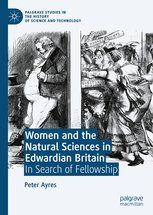MAKING BRITISH BOTANY
Introduction. This is all about the people who helped shaped botany in the late-Victorian years through to World War II. It might be called 'Women Making British Botany', since it concentrates on the too often forgotten contributions of their sex. These women range from university-educated, laboratory scientists, to self-taught but highly knowledgeable 'plantswomen'.
In this period there were increasing opportunities for professional, salaried, ‘plant scientists’, while amateur ‘botanists’ found it more and more difficult to contribute to the academic aspects of the subject. ‘Pure’ science vied with ‘applied science’, while all too often female graduates competed unsuccessfully with male graduates for paid employment.
Some but not all of the subjects have appeared in the books shown at the bottom of this page. This site does not attempt to repeat what is in those books. Its aim is to present some of what I have learned since those books were published.
Critical to the personal development of individuals were the organisations and structures within which they studied and worked as, in 2020, I described in Women and the Natural Sciences in Edwardian Britain. In Search of Fellowship. Change and innovation were often driven by war. In both World Wars I and II there was a desperate need for British-grown medicinal plants (Britain's Green Allies. Medicinal Plants in Wartime); the 'plantswomen' came to the fore.
The starting point is an old friend, Harry Marshall Ward, for it is while he was Professor of Botany in Cambridge (1895-1906) that graduate-level education of women took off.
In Harry Marshall Ward and the Fungal Thread of Death (see below), I described how, for Marshall Ward and his friends, ‘The Cause’ was the establishment of a vigorous botanical school in Britain, independent of Germany. (To understand why Germany was important in the completion of Harry Marshall Ward's education, turn to Julius von Sachs). What I hadn’t realised until very recently was that Marshall Ward had borrowed the term from what was to be a much larger and, ultimately, more important movement.
Manchester was the cradle of the women’s suffrage movement, thanks to the leadership of Lydia Becker, Richard and Emmeline Pankhurst, Jacob Bright, and many others with local connections. As early as 1868 they were referring to their mission as ‘The Cause’. Harry would probably have become aware of the movement and its rallying cry in 1875 when he had spent the autumn term at Owens College, Manchester. There he met his future wife, Selina Kingdon. In 1876 they began their seven year engagement, Selina writing to him from Manchester while he was in Cambridge and then Ceylon (Sri Lanka). He and his botanical friends must have known well what they were doing when they spoke of ‘The Cause’. One likes to think there was a touch of good humour in its adoption.
The women whose brief biographies appear later all passed through the Cambridge Botany School during his professorship. They were either taught by him as under-graduates of Newnham or Girton Colleges (one particular class is selected) or whose post-graduate research in the Botany School was inspired by Marshall Ward's teaching (though in a few cases supervised by Ward's colleagues, particularly FF Blackman or Charles Seward).
Next: see The Marshall Ward Society, my starting point.
Peter Ayres
Last updated 8 December 2022



Ayres, PG. 2005. Harry Marshall Ward and the Fungal Thread of Death. American Phytopathological Society. St. Paul: Mn.
Ayres, PG. 2020. Women and the Natural Sciences in Edwardian Britain. In Search of Fellowship. Palgrave MacMillan: London.
Ayres, PG. 2015. Britain's Green Allies. Medicinal Plants in Wartime. Matador: Leicester. (Hard copies available from the author: ptgaayres@gmail.com).